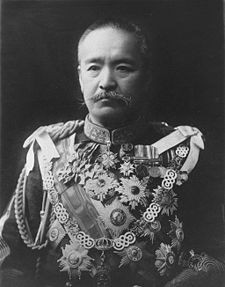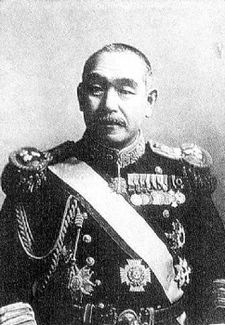
Chamberlain of Japan
Encyclopedia

Emperor of Japan
The Emperor of Japan is, according to the 1947 Constitution of Japan, "the symbol of the state and of the unity of the people." He is a ceremonial figurehead under a form of constitutional monarchy and is head of the Japanese Imperial Family with functions as head of state. He is also the highest...
. He also keeps the Privy Seal
Privy Seal of Japan
The Privy Seal of Japan is the Emperor of Japan's official seal. It is square and its inscription "天皇御璽" is written in the seal script . It has two lines of vertical writing. On the right-hand side is "天皇" and on left-hand side is "御璽"...
and the State Seal
State Seal of Japan
The Great Seal of Japan is the Japanese official seal of state. It is cubic. The characters 大日本國璽 are carved in the archaic Chinese Seal script...
and has been an official civil servant since the Meiji Period
Meiji period
The , also known as the Meiji era, is a Japanese era which extended from September 1868 through July 1912. This period represents the first half of the Empire of Japan.- Meiji Restoration and the emperor :...
. Today the Grand Chamberlain, assisted by a Vice-Grand Chamberlain, heads the Board of the Chamberlains, the division of the Imperial Household Agency
Imperial Household Agency
The is a government agency of Japan in charge of the state matters concerning Japan's imperial family and also keeping the Privy Seal and the State Seal...
responsible for organising the daily life and schedule of the Emperor. In old Japanese, the Chamberlain was also known as .
History
According to Taihō CodeTaiho Code
The was an administrative reorganization enacted in 701 in Japan, at the end of the Asuka period. It was historically one of the . It was compiled at the direction of Prince Osakabe, Fujiwara no Fuhito and Awata no Mahito...
around the 8th century, it was presupposed that a chamberlain belonged to the Ministry of the Center
Ministry of the Center
The was a division of the eighth century Japanese government of the Imperial Court in Kyoto, instituted in the Asuka period and formalized during the Heian period. The Ministry was replaced in the Meiji period.-Overview:...
. When the was installed during the Heian era, the Chamberlain's role was quickly reduced, limited to matters of courtesy. In 1869, the Chamberlain was brought within the Imperial Household Ministry. The position of Grand Chamberlain of Japan was placed within the merit system in 1871, and three people—Tokudaiji Sanetsune, Kawase Masataka, and Higashikuze Michitomi—were appointed. According to the Imperial Household Ministry regulations, the Grand Chamberlain supervises chamberlains who closely attend the appointed person, reports to that person and announces their orders.
After World War II
World War II
World War II, or the Second World War , was a global conflict lasting from 1939 to 1945, involving most of the world's nations—including all of the great powers—eventually forming two opposing military alliances: the Allies and the Axis...
, the Chamberlains were organized into the Board of the Chamberlains, within the Imperial Household Agency, through the temporary . After passage of the National Public Service Law (Shōwa 22 Law No. 120), the chamberlain became a special service national public servant. Although distinctions between first-class officials, second class officials, and so forth continued, the class publication to an appointment document would no longer be carried out after the 2001 Central Government Reform
2001 Central Government Reform
The by the Japanese government involved the establishment of a new ministry, the merging of existing ministries and the abolition of others. This resulted in little more than a change of ministry names .-External links:*...
. The grand chamberlain's job is that of an attestation official, and his appointment and dismissal are at the discretion of the Emperor.
Crown Prince
The Crown Prince of JapanNaruhito, Crown Prince of Japan
is the eldest son of Emperor Akihito and Empress Michiko, which makes him the heir apparent to the Chrysanthemum Throne of Japan.-Early life and education:...
is also served by a Chamberlain. This official is called in Japanese because the Crown Prince lives in the . The Chief Chamberlain to the Crown Prince is the head of the Crown Prince's Household.
List of Grand Chamberlains of Japan
(After Meiji PeriodMeiji period
The , also known as the Meiji era, is a Japanese era which extended from September 1868 through July 1912. This period represents the first half of the Empire of Japan.- Meiji Restoration and the emperor :...
)

- Tokudaiji Sanetsune (徳大寺実則), 1871–77
- Kawase MasatakaMasataka KawaseViscount , a.k.a. ' was a Japanese Shishi, and later, a diplomat.He attended some battle in 1860s at Chōshū Domain. Especially, in 1865, he was the commander in Kōzan-ji uprising, as Hirobumi Ito, under Shinsaku Takasugi. He also served at the Second Chōshū expedition, and led the Chōshū Army to...
(河瀬真孝), 1871–73 - Higasikuze Michitomi (東久世通禧), 1871–77
- Yamaguchi Tadasada (山口正定), 1878–84
- Yoneda Torao (米田虎雄), 1878–84
- Tokudaiji Sanetsune (徳大寺実則), 1884–12
- Hatano Norinao (波多野敬直), 1912
- Katsura TarōKatsura TaroPrince , was a general in the Imperial Japanese Army, politician and three-time Prime Minister of Japan.-Early life:Katsura was born into a samurai family from Hagi, Chōshū Domain...
(桂太郎), 1912 - Takatsukasa HiromichiTakatsukasa Hiromichi, son of Kujō Hisatada and adopted son of Takatsukasa Sukehiro, was a kazoku of the Meiji period who served in Imperial Japanese Army. Nobusuke and Nobuhiro were his sons....
(鷹司煕通), 1912–18 - Ogimachi Sanemasa (正親町実正), 1919–22
- Tokugawa SatotakaTokugawa SatotakaCount was a Japanese samurai of the late Edo period who became a government official in the Meiji, Taishō, and Shōwa eras. Younger brother of Tokugawa Iesato....
(徳川達孝), 1922–27 - Chinda SutemiChinda SutemiCount was a Japanese diplomat. In 1877 he went to study at DePauw University. He got his BA in 1881, and MA in 1884. In 1882 he married, and subsequently had one son.-Diplomatic career:...
(珍田捨巳), 1927–1929 - Suzuki KantarōKantaro SuzukiBaron was an admiral in the Imperial Japanese Navy, member and final leader of the Taisei Yokusankai and 42nd Prime Minister of Japan from 7 April-17 August 1945.-Early life:...
(鈴木貫太郎), 1929–36 - Hyakutake Saburō (百武三郎), 1936–44
- Fujita HisanoriHisanori Fujitawas a Japanese naval officer, and after retiring from the navy was an assistant to the Emperor of Japan during World War II.Fujita graduated from the Japanese Naval Staff College, and became Commander of the Japanese battleship Kirishima on December 1, 1924. In 1929, he attained the rank of...
(藤田尚徳), 1944–47
(After enforcing Constitution of Japan
Constitution of Japan
The is the fundamental law of Japan. It was enacted on 3 May, 1947 as a new constitution for postwar Japan.-Outline:The constitution provides for a parliamentary system of government and guarantees certain fundamental rights...
by the end of the WWII)
- Ōgane Masujirō (大金益次郎), 1947–48
- Mitani Takanobu (三谷隆信), 1948–65
- Inada Syūichi (稲田周一), 1965–69
- Irie Sukemasa (入江相政), 1969–85
- Tokugawa Yoshihiro (徳川義寛), 1985–88
- Yamamoto Satoru (山本悟), 1988–96
- Watanabe Makoto (渡邉允, 12 December 1996–2007
- Kawashima Yutaka (川島裕), 2007–

